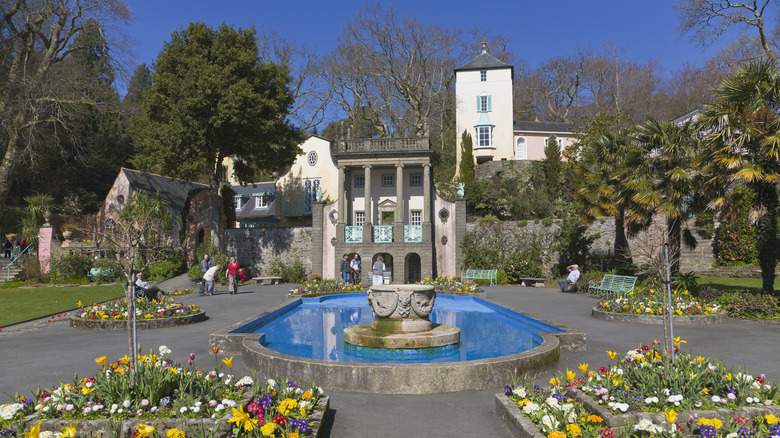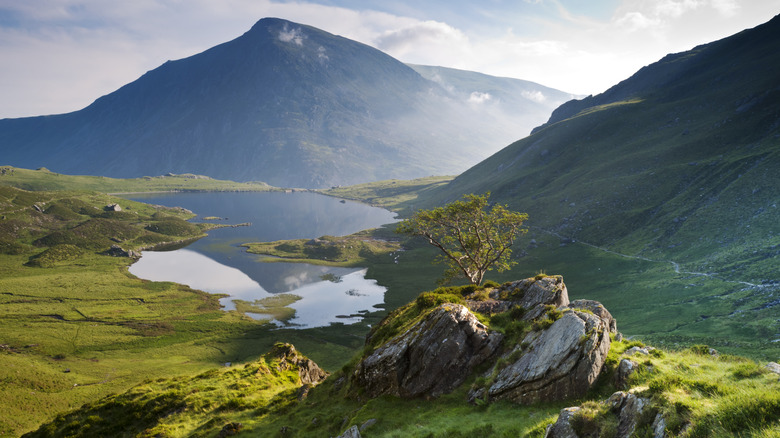Get A Slice Of Italy At This Unique, Under-The-Radar Resort Village In The United Kingdom
"I am not a number, I'm a free man!" shouts the kidnapped spy at the start of "The Prisoner," the cult British TV series from the 1960s. Held in "The Village" by unknown diabolical forces, "Number 6" tries to escape his captors each episode, with failure usually following success. The series' co-star was the village itself, the strange seaside resort town of Portmeirion, on the northwest coast of Wales. Built between 1925 and 1975 by the eccentric visionary, Sir Clough Williams-Ellis, Portmeirion creates an Alice-in-Wonderland-like world that continues to draw in those with a taste for the bizarre.
It comes with an Italian flavor, too, as Portmeirion was built with places like Portofino of the Cinque Terre region in mind. To capture this Mediterranean spirit, Williams-Ellis installed Riviera-style buildings in bright pastels, ornamental gardens, and several piazzas, with sea breezes coming care of the Dwyryd Estuary and Irish Sea. Although the result is more a hodgepodge than the uniformly sculpted seaside villages of Italy, it nevertheless emanates the charm, which is accentuated by the staid British-style villages surrounding it. Most of the buildings in Portmeirion are follies created for the resort, but others — or fragments of them — were moved there to boost the Italian fantasy, if not the fact. The result makes a whimsical pizza that may not authentically reflect what comes out of the ovens in Naples but still tastes delicious.
Portmeirion behind the scenes
Little in Portmeirion is what it seems. Windows on one side of a building may be real but painted on the other, like those of the Cliff House. Another building, the Unicorn, fronts as a large Georgian mansion but actually houses just two, flat-roofed hotel suites behind it. Still others play with perspective, appearing full size from a distance but shrinking as you walk toward them. These practical jokes are not incidental but integral to the vision of Sir Clough Williams-Ellis, who delighted in playing with guests' perceptions. That's echoed by the many hybrid buildings containing both real and fake elements.
Williams-Ellis acquired the land in 1925 to build his ideal village. He hoped to demonstrate how to develop a naturally beautiful location without spoiling it – and even enhance it. Construction of Portmeirion lasted 50 years, starting from the dilapidated 1850 mansion by the water and filling the steep banks around it with new, salvaged, and blended buildings. A good example is the campanile, which was built in the 1920s partly with stone from a 12th-century castle and a clock from a demolished London brewery. Other buildings were brought in wholesale, including two 18th-century neo-Classical bathhouse colonnades, a Gothic gatehouse, Baroque houses, a Chinese pagoda, and Cotswoldian cottages. His own description of Portmeirion was "a home for fallen buildings."
Visiting the coast of Wales
While described as a village, Portmeirion is a resort with an entry fee. After hours, the village becomes the sole domain of overnight guests at the two hotels onsite. There are also 32 suites and 13 self-catering cottages scattered throughout the property. Another 23 spots inside the village can host motorhomes. Fans of "The Prisoner" will love the TV channel playing the series 24/7, especially those who arrive each year for the Prisoner Convention , a three-day celebration with ample cosplay. Otherwise, aim to visit for the Steampunk Weekend, Food and Craft Fair, live music days, or during the perfect time to visit, according to Rick Steves.
A stay in Portmeirion also offers easy access to the highlights of north Wales. A few miles east is Eyrie National Park (Snowdonia), home to Wales' highest mountain, largest lake, and spiritual heart. Travelers can head northwest to the Isle of Anglesey, the "mother of Wales," where the Druids made their last stand against the Romans. Today, it's covered with sacred sites for the Welsh nation, many of which are along the 130-mile Anglesey Coastal Path, part of the longer Wales Coast Path. Nearby is Caernarfon, where King Edward I built the massive medieval castle that remains an attraction today. These sites are just a few of the many reasons to visit Wales.


